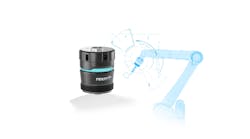The Smart Flex Effector from Bosch Rexroth is a sensor-based compensation module designed to provide robots and Cartesian linear systems human-like sensitivity, aiding with factory automation applications. Due to its sensitive touch, the position of work pieces is precisely recorded and passed to the robot control unit for active compensation.
Features of the Smart Flex Effector include:
- load handling of up to 6 kg
- new application possibilities
- ability to recognize positional deviations
- RS-485 and I/O interfaces allow exchange of data
New Application Possibilities
According to Bosch Rexroth, its Smart Flex Effector features a kinematics system capable of working independently in six degrees of freedom which helps to enable sensitive touch in a variety of applications. These can include joining processes with minimal tolerances, complex assembly work or difficult handling tasks.
With its ability to handle loads up to 6 kg, the Smart Flex Effector allows use in applications which could be difficult for other types of equipment such as passive compensation units, force torque sensors and visual systems.
The effector's differentiated kinematics enables correction of processes, even those with great complexity and tight tolerances states Bosch Rexroth in its press release announcing the release of the Smart Flex Effector. This is beneficial in cases of positional deviations between the tool and work pieces or in complex joining processes with minimal tolerances the company said.
Due to its ability to provide a sensitive touch, the effector can help to automate processes through the use of a robot which previously were not possible. The company said parts made of glass or other fragile materials can be handled by the effector, aiding a number of manufacturing operations.
Technology Improves Quality, Productivity
An integrated sensor system helps the effector to determine the exact position of an object which can be beneficial during sampling applications. The Smart Flex Effector is also able to recognize positional deviations, providing further accuracy and productivity for customers. These deviations are immediately recognized and corrected or reported to the control system, helping to avoid errors and extra costs due to rejected products or rework.
Objects picked up by the effector can be positioned in a controlled manner said Bosch Rexroth. They are then reliably placed or sorted due to integrated technology which allows for such precise work. To keep operations moving at a productive pace, the effector's compensation module can be actively moved into the zero position and electromechanically locked for fast transfer runs the company said.
Teaching robots equipped with the Smart Flex Effector takes less time than with previous technologies because of the effector's 6D position recording. This enables the robotic control system to read the exact coordinates for gripping and placing points directly explained Bosch Rexroth, as well as automating repeated learning during operation. Robots equipped with the effector can be taught manually as well by moving them by hand into the correct positions.
Additional built-in technology, such as the RS-485 and I/O interfaces, allow the exchange of data, helping manufacturers to better monitor their operations. The Smart Flex Effector provides easy installation as well and enabling data transmission as soon as it is connected. This helps customers get working right away while also making it easy to retrofit systems where necessary.


